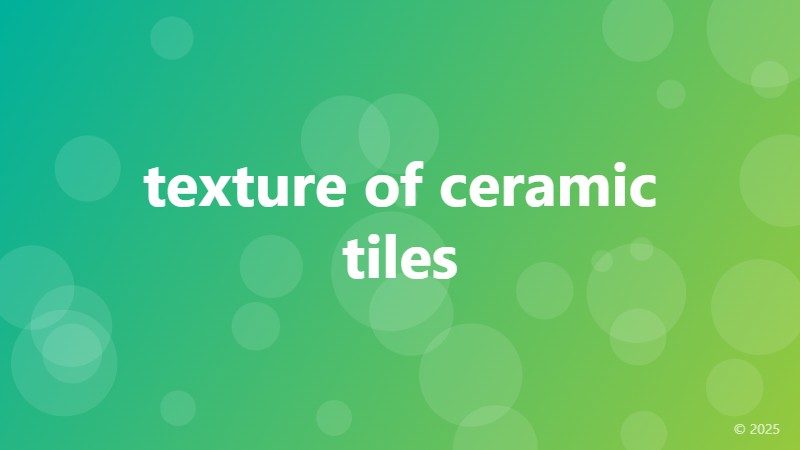texture of ceramic tiles

Understanding the Texture of Ceramic Tiles
Ceramic tiles have become a popular choice for homeowners and interior designers alike, thanks to their durability, ease of maintenance, and versatility in design. One of the key factors that contribute to the aesthetic appeal of ceramic tiles is their texture. The texture of ceramic tiles can greatly impact the overall look and feel of a room, and with so many options available, it's essential to understand the different types of textures and their characteristics.
Types of Textures in Ceramic Tiles
There are several types of textures found in ceramic tiles, each with its unique characteristics and advantages. Some of the most common textures include:
Matte Finish: A matte finish ceramic tile has a flat, non-reflective surface that absorbs light, giving it a soft and subtle appearance. This texture is ideal for creating a minimalist look and is often used in modern and contemporary designs.
Glossy Finish: A glossy finish ceramic tile has a high-shine surface that reflects light, making it perfect for creating a sense of luxury and sophistication. This texture is often used in traditional and classic designs.
Textured Finish: A textured finish ceramic tile has a raised or embossed pattern on its surface, giving it a tactile quality that adds depth and visual interest to a room. This texture is ideal for creating a rustic or natural look.
Rough Finish: A rough finish ceramic tile has a coarse, unfinished surface that gives it a rugged and industrial look. This texture is often used in modern and industrial designs.
The Importance of Texture in Ceramic Tiles
The texture of ceramic tiles plays a crucial role in determining the overall aesthetic and functional value of a room. Here are some reasons why texture is important:
Aesthetic Appeal: The texture of ceramic tiles can greatly impact the visual appeal of a room. Different textures can create different moods and ambiances, from modern and sleek to rustic and cozy.
Slip Resistance: The texture of ceramic tiles can also affect their slip resistance. Textured tiles with a rougher finish can provide better traction, making them ideal for areas with high foot traffic or moisture.
Maintenance: The texture of ceramic tiles can also impact their maintenance requirements. Smooth tiles are easier to clean and maintain, while textured tiles may require more effort to keep them looking their best.
Conclusion
In conclusion, the texture of ceramic tiles is a crucial factor to consider when selecting the perfect tile for your home or design project. With so many different textures available, it's essential to understand the characteristics and advantages of each to create a space that is both aesthetically pleasing and functional. By considering the type of texture that best suits your needs and design style, you can create a beautiful and long-lasting space that you'll love for years to come.